13. Examples of particle interactions described in terms of
Feynman vertices
1. neutron decays to a proton, electron and an
anti-electron neutrino
2. pi-plus decays to
mu-plus and a muon neutrino
3. a positive muon decays
to a muon antineutrino, a positron and an electron neutrino
4 K zero decays to a
pi-minus and pi-plus via the weak interaction
5. lambda zero decays to a proton and a pi-minus via the weak
interaction
6 a sigma plus decays to a proton and a pi-zero via the weak
interaction
7. electron positron
annihilation to two photons
8 xi-zero decays to a lambda zero
and a pi-zero
9 positive kaon decays to three
pions
10. sigma-zero decays to lambda zero and a photon
11. omega minus decays to xi-zero and a negative pion
12. positive kaon interacts with a proton to produce a
neutral kaon and a delta++
13. antiproton interacts with a proton to produce a neutron
and an antineutron
14. omega-minus decays to xi-zero, an
electron and an electron antineutrino
Example 1

In this case a neutron
decays to a proton, an electron and an anti-neutrino via the weak interaction.
The quark analysis
shows:

d®d
u®u
d®u
with the creation of an electron and an anti-neutrino.
The corresponding Feynman diagram will be:
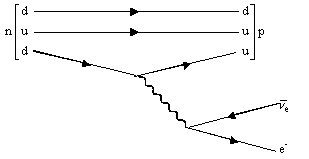
This is a weak decay of the down quark. It is an allowed
vertical change in the same quark generation.

The Feynman diagram for the d to u transition is a
combination of quark-W vertex and same generation lepton W vertex.
Return to top of page
Example 2

In this example the up and the antidown quarks in the pi-plus annihilate to
produce a W+. The W+ then materialises the lepton-antilepton
pair.

The Feynman diagram is a simple combination of a quark weak vertex and a
lepton-weak vertex. The quarks come form the same generation. Similarly, the
leptons are a first generation pair.
Return to top of page
Example 3

In this example the positive muon emits a W+ and transforms to a
muon antineutrino. The W+ then materialises a lepton-antilepton pair
from the first generation of the antilepton family.
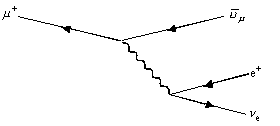
Return to top of page
Example 4

In this case a kaon-zero decays to a
pi-minus and pi-plus via the weak
interaction.
The quarks analysis shows:


 with the creation of an
antidown - up pair.
with the creation of an
antidown - up pair.
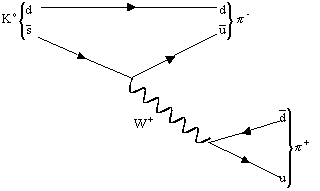
This is a weak decay of the anti-strange quark. It is an allowed diagonal
change between anti-quark generations.
The Feynman diagram shows a combination of an antiquark-weak vertex and a
quark-weak vertex.
Return to top of page
Example 5

In this case a lambda zero decays to a proton and a pi-minus via the weak
interaction.
The quark analysis shows:

u ® u
d ® d
s ® u
with the creation of a down - antiup pair.
The corresponding Feynman diagram will be:
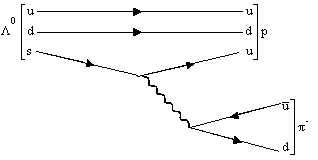
This is a weak decay of the strange quark. It is an allowed diagonal change
between quark generations.

The Feynman diagram for the s to u transition is a combination of two quark-W vertices.
The pion is derived from a same generation quark weak vertex
Return to top of page
Example 6

In this case a Sigma plus decays to a proton and a pi-zero via the weak
interaction.
The quark analysis shows:

u ® u
u ® u
s ® u
with the creation of a down - antiup pair.
The corresponding Feynman diagram will be:
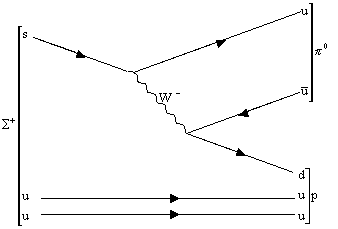
This is a weak decay of the strange quark. It is an allowed diagonal change
between quark generations.

The Feynman diagram for the s to u transition is a combination of two quark-W vertices.
Return to top of page
Example 7

This is an annihilation of a positron and an electron.
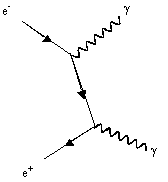
The electron emits a real photon and becomes a virtual electron. This virtual electron then annihilates with the positron with the emission
further photon. It is a combination of two electromagnetic-lepton vertices.
Return to top of page
Example 8
X0
à
L0
+ p0
A xi-zero (uss) decays into a lambda zero (uds) and a pi zero ( )
)
The quark analysis shows:
X0
à
L0
+ p0
s
à s
u à
u
s
à u with the creation of a down-antiup
pair.
The
corresponding Feynman diagram will be:
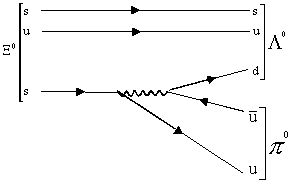
This is a weak decay of the strange quark. It is an allowed diagonal change
between quark generation:

We also can see a quark weak vertex leading to a anti-up and a down quark.
This event involves only neutral particles and you may think that it could
never be "seen" in a bubble chamber picture. BUT...
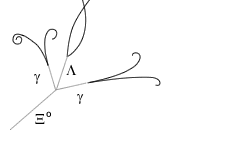
The signalled tracks in the picture above shows the xsi zero decay, in the bubble
chamber picture of the discovery of omega minus! The two gammas come from pi
zero disintegration!
Return to top of page
Example 9

In
this case a kaon-plus decays to a pi-minus and two pi-plus via the weak
interaction and a gluon.
The
quark analysis shows:

u ® u


This is a weak interaction of the anti-strange quark to an anti-up quark with
the creation of a W-plus. The W-plus decays and an anti-down quark and an up
quark are created. A gluon is created and materialises a down quark and an
anti-down quark.

The anti-strange to anti-up vertex is an allowed diagonal change between
antiquark generations.
Return to top of page
Example 10

In this case, one of the quarks in the sigma-zero emits a photon. It is a
simple electromagnetic vertex.
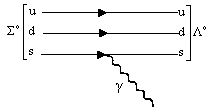
Return to top of page
Example 11
W- à
X0 + p-
A omega minus (sss) decays into a xsi zero (uss) and a pi minus.
The quark analysis shows:
W- à
X0 + p-
s
à
s
s à
s
s
à
u with the creation of a down-antiup
pair.
The
corresponding Feynman diagram will be:
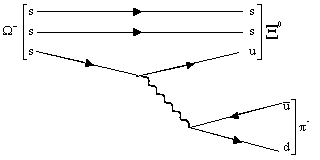
This is a weak decay of the strange quark. It is an allowed diagonal change
between quark generation:

We also can see a quark weak vertex leading to a anti-up and a down quark.
Return to top of page
Example 12

In this case there is a collision between a positive kaon (K+) and a proton
(p)
In the strong interaction a neutral kaon
(K0) and
an excited state (D++) are produced.
The D++ then decays to a proton and a positive
pion.
The suggested Feynman diagram might be:

This is a strong interaction and involves quark-gluon vertices only.
The quark analysis shows:
the up
quark of the kaon emits a gluon and the gluon materializes into a down quark and
an antidown quark
the down quark of the proton annihilates with the
antidown quark emitting a gluon
the three up quarks recombine as an excited state D++
then....
an up
quark of the excited state emits a gluon and the gluon materializes into a down
quark and an antidown quark
an
up quark and the antidown quark recombine as a positive pion
two up and
the down quark recombine as a proton.
Return to top of page
Example 13

In this case there is a collision between a proton (p) and an antiproton (p).
In the final state a neutron and an antineutron are produced.
The quark analysis shows:
the antiup
quark of the antiproton annihilates with the up quark of the proton emitting a
gluon.
the
antidown quark of the antiproton emits a gluon and the gluon materialize into an
antidown and a down quark
The corresponding Feynman diagram will be:

This is a strong interaction and involves quark gluon vertices only.
Return to top of page
Example 14

In this case an Omega minus decays to a xi- zero, an electron and electron anti-neutrino via the weak
interaction.
The quark analysis shows:

s ® s
s ® s
s ® u
with the creation of an electron - antineutrino pair.
The corresponding Feynman diagram will be:
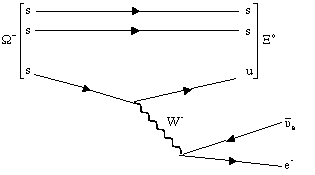
This is a weak decay of the strange quark. It is an allowed diagonal change
between quark generations.

The Feynman diagram illustrates that the reaction is a combination of a quark
weak vertex and a weak-lepton vertex.
Return to top of page
![]()

















